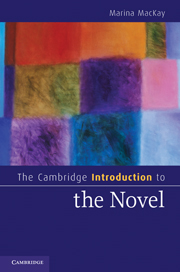Book contents
- Frontmatter
- Contents
- Acknowledgments
- About this book
- Chapter 1 Why the novel matters
- Miguel de Cervantes, Don Quixote (1605, 1615)
- Chapter 2 Origins of the novel
- Laurence Sterne, The Life and Opinions of Tristram Shandy, Gentleman (1759–67)
- Chapter 3 Narrating the novel
- James Hogg, The Private Memoirs and Confessions of a Justified Sinner (1824)
- Chapter 4 Character and the novel
- Nathaniel Hawthorne, The Scarlet Letter (1850)
- Chapter 5 Plotting the novel
- Gustave Flaubert, Madame Bovary (1857)
- Chapter 6 Setting the novel
- Charles Dickens, Bleak House (1853)
- Chapter 7 Time and history
- Virginia Woolf, To the Lighthouse (1927)
- Chapter 8 Genre and subgenre
- Graham Greene, The Ministry of Fear (1943)
- Chapter 9 Novel and anti-novel
- Thomas Pynchon, The Crying of Lot 49 (1966)
- Chapter 10 Novel, nation, community
- Salman Rushdie, Midnight's Children (1981)
- Chapter 11 Concluding
- Notes
- Glossary
- Further reading
- Index
- Cambridge Cultural Social Studies
Nathaniel Hawthorne, The Scarlet Letter (1850)
Published online by Cambridge University Press: 05 June 2012
- Frontmatter
- Contents
- Acknowledgments
- About this book
- Chapter 1 Why the novel matters
- Miguel de Cervantes, Don Quixote (1605, 1615)
- Chapter 2 Origins of the novel
- Laurence Sterne, The Life and Opinions of Tristram Shandy, Gentleman (1759–67)
- Chapter 3 Narrating the novel
- James Hogg, The Private Memoirs and Confessions of a Justified Sinner (1824)
- Chapter 4 Character and the novel
- Nathaniel Hawthorne, The Scarlet Letter (1850)
- Chapter 5 Plotting the novel
- Gustave Flaubert, Madame Bovary (1857)
- Chapter 6 Setting the novel
- Charles Dickens, Bleak House (1853)
- Chapter 7 Time and history
- Virginia Woolf, To the Lighthouse (1927)
- Chapter 8 Genre and subgenre
- Graham Greene, The Ministry of Fear (1943)
- Chapter 9 Novel and anti-novel
- Thomas Pynchon, The Crying of Lot 49 (1966)
- Chapter 10 Novel, nation, community
- Salman Rushdie, Midnight's Children (1981)
- Chapter 11 Concluding
- Notes
- Glossary
- Further reading
- Index
- Cambridge Cultural Social Studies
Summary
This rag of scarlet cloth, – for time, and wear, and a sacrilegious moth, had reduced it to little other than a rag, – on careful examination, assumed the shape of a letter. It was the capital letter A.
Nathaniel Hawthorne, The Scarlet Letter (1850)In the frame story of The Scarlet Letter Hawthorne discovers a package containing an ancient piece of embroidery that he identifies as the letter “A,” along with a brief narrative, written by a predecessor in the Customs House where he works, about the woman who created and wore that “character.” By beginning with the character A, Hawthorne reminds us that the foundations of literary character, the fictional person, are in the written and the interpretable. The Scarlet Letter is a novel about a character, the intensely memorable character of Hester Prynne, but it's also a novel about what character means.
The long Customs House prologue introduces the first of many meanings of “character.” Conversationally, a “character” is an eccentric, an oddball, known by sight throughout a community, and the prologue takes the form of a “gallery of Custom-House portraits” (21), a description of the odd people with whom Hawthorne works, among them the man who has lost his entire family but thinks of nothing but cheerful gourmandizing. These are indeed “characters” in the colloquial sense. And this first meaning of character matters because the narrator initially imagines Hester Prynne as a character of this type.
- Type
- Chapter
- Information
- The Cambridge Introduction to the Novel , pp. 79 - 82Publisher: Cambridge University PressPrint publication year: 2010

